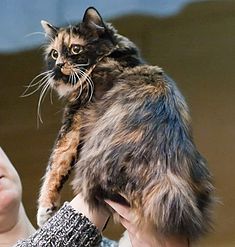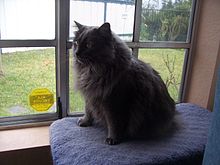- Cymric (cat)
-
Cymric Alternative names Long-haired Manx, Longhair Manx, Manx Longhair Origin Isle of Man, Canada Breed standard FIFe standard WCF standard TICA standard AACE standard ACFA standard ACF standard CCA standard Notes TICA and ACF recognize the Cymric by name as a variety of Manx; CFA and GCCF do not recognize the breed; NZCF recognizes its existence as Longhair Manx[1]but publishes no breed standard. Cat (Felis catus) The Cymric (/ˈkɪmrɨk/ kim-rik or /ˈkʌmrɨk/ kum-rik) is a breed of domestic cat. Some cat registries consider the Cymric simply a semi-long-haired variety of the Manx breed, rather than a separate breed. Except for the length of fur, in all other respects the two varieties are the same, and kittens of either sort may appear in the same litter. The name comes from Cymru ([ˈkəm.rɨ], kəm-ree), the indigenous Welsh name of Wales, though the breed is not associated with Wales, and the name was possibly given as an attempt to provide a "Celtic"-sounding name for the breed. The breed's Manx bloodline originated in the Isle of Man, though Canada claims to have developed the long-haired variant. The breed is called the Long-haired Manx or Longhair Manx by some registries, and has also been called the Manx Longhair.
According to Isle of Man records,[weasel words] the taillessness trait of the Manx (and ultimately the Cymric) began as a mutation among the island's domestic cat population. Given the island's closed environment and small gene pool, the dominant gene that decided the cats' taillessness was easily passed from one generation to the next, along with the gene for long hair. Long-haired kittens had been born to Manx cats on the Isle of Man, but had always been discarded by breeders as "mutants". Then, in the 1960s, similar kittens were born in Canada and were intentionally bred. This was the start of the increase of Cymric popularity. It took many years for the Cymric to be recognized as a breed of its own by cat associations. The Manx was recognized in the 1920s, but the Cymric was not shown until the 1960s and did not begin to gain popularity until the mid-1970s.
Characteristics
The Cymric is a muscular, compact, medium to large cat with a sturdy bone structure. They weigh between seven and thirteen pounds and have a round appearance. Cymrics have large and full eyes and have widely spaced ears. The hair of a Cymric is medium-long, dense and well padded over the main body, adding to the round appearance. All colors and patterns are accepted and eye color can be copper, green, hazel, and blue although other colors have been found.
In the breed of Cymrics, four different tail types are produced. The "rumpy" is the most valuable. This is a cat born entirely tailless. Instead, rumpies often have a dimple at the base of the spine where the tail would be. Next, there are "rumpy-risers". These cats have a short knob of tail that is made up of one to three vertebrae connected to the spine. "Stumpies" have a short tail stump that is usually curved, knotted, or kinked. Finally, "longies" have tails almost as long as an ordinary cat’s. However, most breeders dock the tails of longie kittens four to six days after birth. It is impossible to predict what tail types will appear in any given litter.
Cymrics are intelligent, fun-loving cats, and they get along well with other pets, including dogs. Cymrics are very loyal to their humans and enjoy spending quality time with them. As cats go, they can be easily taught tricks. Despite their playful temperament, they are gentle and nonaggressive. However, Cymrics are usually not overly demanding of attention. Cymrics are very playful and are exceptional jumpers. Like Manx, Cymrics are fascinated by water.
Genetic disorders
The gene that gives the Cymric and Manx their unusual tails can also be lethal. Kittens who inherit two copies of the tailless gene die before birth and are reabsorbed in the womb. Since these kittens make up about 25 percent of all kittens, litters are usually small. Even cats who inherit only one copy of the gene can have what is called Manx syndrome. This can cause Spina Bifida, gaps in the vertebrae, fused vertebrae, and bowel or bladder dysfunctions. Also, a rabbit-like hop can sometimes be seen in Cymric cats due to the spinal deformity.
Not every Cymric with a short spine has problems or Manx Syndrome. It is simply an attribute of the Manx gene, and its expression cannot be entirely prevented. The problems usually become apparent within the first six months of age, Cymric and Manx kittens are usually kept by breeders until older before being made available.
References
- ^ "Breed Code MAN – Manx". NZCF.com. New Zealand Cat Fancy. January 2007. http://www.nzcf.com/sop/Manx.pdf. Retrieved 2011-11-18.
Categories:- Cat breeds
- Cat breeds originating in the Isle of Man
Wikimedia Foundation. 2010.


